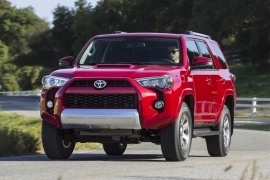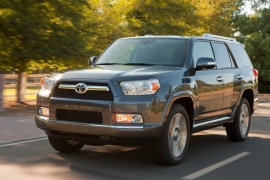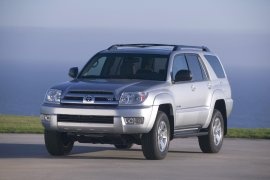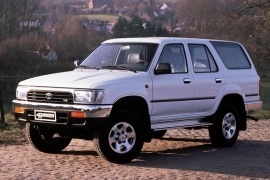
TOYOTA 4Runner
Generations Timeline, Specs and Pictures

In 2013, the Toyota 4Runner received an update for the 2014 model-year, coming with a bolder design via the slightly redesigned front and rear fascias with more muscular shapes, while the interior got upgraded materials, more knee room for the second-row passengers as well as more standard features, including air conditioning, fabric-trimmed seats with the driver’s one being eight-way adjustable, A-TRAC system, Hill-start Assist Control, Downhill Assist Control, backup camera, Toyota Entune multimedia system and the STAR safety system.
The small 2.7-liter engine was dropped and the whole range was powered by the 4-liter V6 engine, with a choice of two- or all-wheel-drive. The engine was teamed to a five-speed ECT-i automatic transmission and a transfer case.
There were three trim levels: SR5, Limited and Trail. The SR5 and Trail grades rode on 17-inch alloy wheels with a new wheel-design for both, while the Limited came with 20-inch alloy wheels, which were painted black prior to machining to add contrast. All grades came standard with a full-size spare.
The off-roader enthusiast went for the Trail version, which came with an electronic-locking rear differential. That trim also had a higher ground clearance and better approach, brakeover and departure angles. The Trail grade also features a Multi-Terrain Select system that dials in wheel-slip control to match the terrain.

Toyota introduced the fifth generation of the 4Runner in 2009, and it was already a known, trustworthy SUV desired by those who didn’t want to go chasing animals through the forests.
With a vast off-road experience, Toyota had it’s saying on the SUV market, especially on the mid-size segment where the 4Runner sat. Even though it was introduced as a less-utilitarian version for the HiLux, it became a closed-body vehicle with four doors and a tailgate. Moreover, it was also available with a 2WD system. But for the off-road enthusiasts, the carmaker offered a Trail version, which was more capable with a low-range gear and rear locking differential. After all, it was based on the same FJ-Cruiser ladder-chassis.
The exterior design was more of an improvement over the fourth generation. Its blacked-out grille and prominent, angular headlights made the car looks business. The flared fenders were already a styling signature for the 4Runner, and the customers required that. Behind the four doors with black grab-handles, the carmaker added a raked-forward third window. At the back, a roof spoiler adorned the top of the tailgate.
Inside, the 4Runner shared some of the ideas found in the Lexus GX460. Its beefy controls from the center stack were made to be operated with gloves on. Its triple-pad layout in the instrument panel looked sporty, with the speedometer in the middle, the tachometer on the left, and three gauges on the right sharing the same dial. In the back, the carmaker installed a 60/40 split-bench where three adults could fit well. A third-row sitting bench was optional. With all the seats down, the 4Runner offered 2,548 liters (90 cu-ft) of space, while with all seats in place provided (1,217 liters) 43 cu-ft.

The fourth generation of the Toyota 4Runner was introduced in 2002 and it followed the basic principle of its predecessors, featuring a body-on-frame construction and a rugged driveline.
The 4Runner evolved from a modified pickup truck, such it was the T100, to an SUV but without damaging the off-road abilities. Since the third generation, the 4Runner designers were focused on the daily driving needs, offering more comfort and amenities for the driver and passengers. It was offered even in a 2WD configuration, for those who were on the market for an SUV, but didn’t need traction on all four wheels.
On the outside, the 4Runner kept the rugged appearance, with a chromed grille for the SR5 trim level and 16” light-alloy wheels. For the Sport Edition, the 4Runner was equipped with 17” wheels. The Limited level added another inch to the size of the wheel.
The interior was fitted as standard with 5 seats but up to seven were available for the SR5 and Limited. The third row could have been removed to clear-up more room for the trunk. For the infotainment unit, there was a 360-watt JBL AM/FM 6-disc sound system with 10 speakers and a 9” LCD screen for the rear-seat entertainment. A navigation system was part of the options list, with a 7” LCD screen.
The 4Runner was available either with a V6 or a V8 for the North American market, but more engine choices were available in other countries, including a 3.0-liter turbocharged diesel engine.

Toyota introduced the 4Runner’s second generation in late 1989 with a closed bodywork and four doors, fixing the main issue of the first generation, but lost the open-top option in the process.
The craze for SUVs and crossovers was not started yet at the beginning of the ’90s when Toyota introduced the second generation. Those were the times when an SUV had to cope with offroad trails, snow, and deep mud paths without tearing a sweat. The carmaker still made it on the same chassis as the HiLux pickup but added some comfort features that made the 4Runner an excellent daily driver, as long as the driver was not in a hurry.
With its four-door bodywork, the 4Runner became a family car overnight. It still had the same rugged appearance with its flat front fascia and short overhang. The carmaker designed the front bumper with a chromed upper side and a black lower side. For those who were still nostalgic for the first generation, Toyota offered a two-door version as well, with a pop-out window for the rear passengers. The tailgate was opened downward in the back, like in a pickup, with the rear window rolled inside.
Inside, Toyota tried to make a car-like interior with a low seating position, which was not very good while offroading, but great in any other situation. The dashboard was simple, narrow, and curved. It sported a wide instrument cluster extended over the center stack where the carmaker placed the climate control unit above the radio cassette player. For the rear passengers, Toyota installed a split-folding bench.
Under the hood, Toyota installed the same engines as its predecessor: an inline-four and a V-6. The main difference was for the drivetrain, where the carmaker traded the older front solid axle with an independent suspension, which provided a much comfortable ride.























































